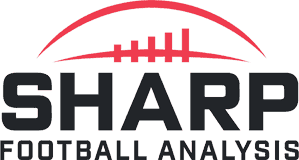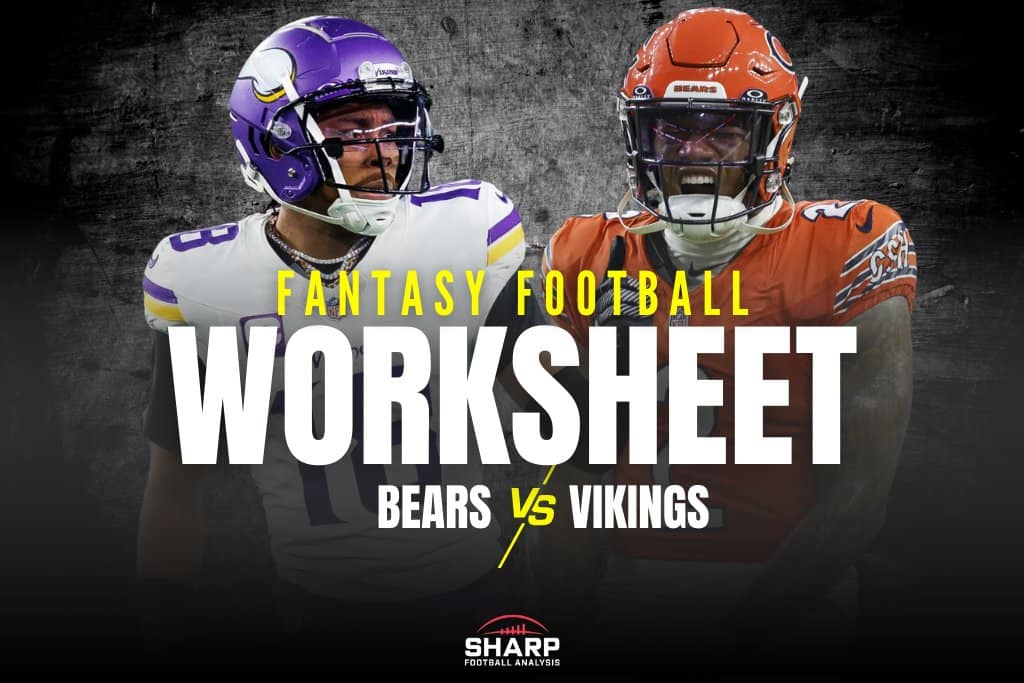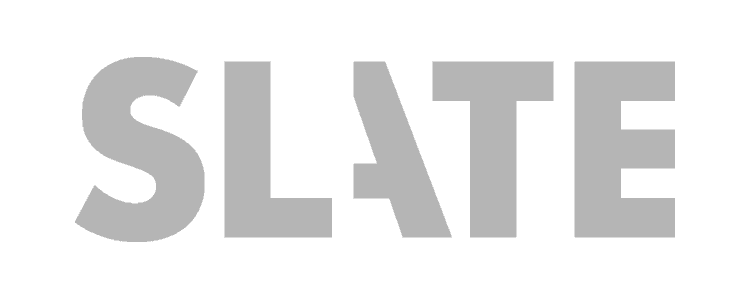The Worksheet, a comprehensive fantasy football preview by Rich Hribar, breaks down everything you need to know about the Week 1 matchup between the Bears and Vikings on Monday Night Football.
Find a breakdown of every Week 1 NFL game in our Worksheet Hub.
| Minnesota | Rank | @ | Chicago | Rank |
|---|---|---|---|---|
| -1.5 | Spread | 1.5 | ||
| 23.0 | Implied Total | 21.5 | ||
| 24.5 | 9 | Points/Gm | 18.2 | 28 |
| 19.9 | 4 | Points All./Gm | 21.8 | 14 |
| 62.5 | 16 | Plays/Gm | 62.6 | 12 |
| 62.7 | 22 | Opp. Plays/Gm | 60.5 | 5 |
| 5.5 | 13 | Off. Yards/Play | 4.5 | 32 |
| 5.3 | 10 | Def. Yards/Play | 5.9 | 30 |
| 42.58% | 18 | Rush% | 40.47% | 25 |
| 57.42% | 15 | Pass% | 59.53% | 8 |
| 36.67% | 1 | Opp. Rush % | 47.18% | 25 |
| 63.33% | 32 | Opp. Pass % | 52.82% | 8 |
- Chicago has a league-worst 5-19 record (.208) in division games over the past four seasons, including a 1-7 record against Minnesota over that span.
- The Vikings have a league-best 26-4 record (.867) in the regular season as a favorite since hiring Kevin O'Connell.
- Chicago scored on 2 of 17 (11.8%) opening drives last season, the lowest rate in the league.
- Opponents scored on 3 of 17 opening drives against Minnesota in 2024, the second-lowest rate in the league.
- The Vikings allowed opponents to score on a league-low 31.6% of their drives in 2024.
- The Bears averaged a league-low 283.5 yards from scrimmage per game in 2024.
- Chicago was the only team in the league without a passing play of 50 or more yards in 2024 (Detroit led the NFL with eight).
- Chicago posted a league-worst -28 sack differential in 2024.
- The Vikings averaged 4.8 sacks plus takeaways per game in 2024, second in the league.
- The Bears allowed 4.9 sacks plus turnovers per game in 2024, 30th in the league.
Trust = spike production for that player
Quarterback
Caleb Williams: Williams disappointingly ended the 2024 season as the QB24 in points per game (15.0).
He logged just five weeks above QB14 in weekly scoring throughout the entire season.
In his first NFL season, Williams completed 62.5% of his passes (31st) for 6.3 yards per pass attempt (33rd).
15.3% of his throws were inaccurate, ahead of only Mac Jones and Anthony Richardson.
Downfield passing was a hangup in his rookie season.
Williams only completed 27.5% of his passes on throws 20 or more yards downfield (31st) and 35.8% of his attempts 10 or more yards downfield (34th) despite being above the league average in rate of those attempts.
He was 15th in attempts over 10 or more yards (33.3%) and seventh in rate of throws 20 or more yards downfield (14.2%).
As a rookie, he lost 108.5 EPA to sacks, the second-worst total for any quarterback in a season in the 2000s.
The offensive line did not do Williams any favors, but he was sacked on 31.6% of his pressures.
The league average was 20.7%.
Williams was credited with 18.7% of his pressures being self-induced per Pro Football Focus, while he took a league-high 17 sacks that were credited as his fault.
Williams and Chicago are overhauling this offense in an attempt to address the issues that arose during his rookie season.
While Williams has consistently had issues with pressure and taking negative plays going back to college, the team did still improve their interior offensive line this offseason, which added support to insulate that part of Williams’ game.
Their most used offensive line combination last season played together for only 34.9% of the snaps, which was 20th in the league.
Seven players played snaps at left guard for them last season, and three played right guard.
Chicago aggressively overhauled its offensive line this offseason by trading for Joe Thuney and Jonah Jackson before signing Drew Dalman in free agency.
The Bears fired their head coach and offensive coordinator during Williams’s rookie season.
This year, they made the most significant splash during the hiring cycle, pulling Ben Johnson away from the Lions.
While Johnson has added flexibility with Williams compared to what he had with Jared Goff in Detroit, he should also do more to put Williams in more traditional dropbacks to help him succeed.
Williams was under center for only 28.8% of his dropbacks (18th) and used play action just 16.9% of the time, the second-lowest rate in the league.
Goff led the league with 55.6% of his snaps under center and a league-high 38% play-action rate.
This preseason, Williams was under center for 47.5% of his dropbacks with a 24% play-action rate.
I will also be interested to see if Johnson uses Williams’ rushing ability near the end zone.
As a rookie, Williams was only 20th in expected rushing points in the red zone (8.9).
Williams rushed for 27 touchdowns in college.
He led last year’s draft class with 7 of his 11 rushing touchdowns in 2023 coming inside of the five-yard line.
While there is newfound excitement with Williams getting on track in year two, the season opens with him as a volatile fantasy option.
Minnesota was second in the NFL last year in passing points allowed per attempt (0.365).
They allowed 7.0 yards per pass attempt (12th) and a 3.8% touchdown rate (7th) to passers.
Williams was boom and bust in his two outings against Minnesota.
He finished as the QB4 (26.9 points) in the Week 12 matchup and then was QB23 (9.9 points) when the teams played in Week 15.
Brian Flores was not as aggressive with Williams as other teams.
Minnesota only blitzed Williams on 28.1% of his dropbacks, below their season average of a 37.5% blitz rate.
Johnson also has familiarity with Flores due to the divisional overlap to offer some outs for Williams producing in Week 1.
JJ McCarthy: Minnesota selected McCarthy 10th overall in last year’s draft, but we never saw him on the field during the regular season.
McCarthy suffered a torn meniscus in the preseason, forcing him to miss the entire year.
We only saw him get 19 dropbacks in the preseason.
We only got to see McCarthy for 8 dropbacks this preseason.
Minnesota has signaled that they are going to insulate McCarthy.
They extended Aaron Jones and Josh Oliver.
In free agency, they added Will Fries and Ryan Kelly.
They traded for Jordan Mason.
They used a first-round pick on guard Donovan Jackson.
This team has indicated that they plan to run the ball more and utilize the play-action game.
If McCarthy can protect the football and avoid the negative plays that Sam Darnold had a year ago, there is a path for him to be efficient in a capacity similar to early-career Brock Purdy.
That said, that outcome will still take a step of faith and could be a slower burn.
Minnesota is opening the year with Justin Jefferson missing the entire preseason and without Jordan Addison due to a suspension.
McCarthy is a QB2 to open the year.
The Bears are also no layup opponent.
Chicago was second in the NFL last season in passing points allowed per game (12.0).
They allowed 7.9 yards per pass attempt (30th), but were able to limit passing touchdowns, allowing a 3.4% touchdown rate (third).
Johnson brought in Dennis Allen as the new defensive coordinator.
Allen’s defense struggled last year in New Orleans, but before that, his teams were top 12 in passing yardage allowed.
Running Back
D’Andre Swift: Swift was a winner this offseason.
The Bears significantly improved their interior offensive line while Swift handled 295 touches for 1,345 yards and 6 touchdowns in an inefficient year behind a poor interior line in 2024.
Chicago did not make a significant backfield addition, while both Roschon Johnson and Kyle Monangai dealt with injuries to close the preseason.
That opens things up for Swift as a volume-based RB2 in Week 1, with added appeal in full-PPR formats.
We may need that volume here unless Swift makes a jump as a runner.
Swift’s 3.8 yards per carry in 2024 were a career low.
He rushed for more yards than expected on only 28.8% of his rushes, the worst rate in the league.
Interior line play was an issue, but Swift was also 45th out of 46 running backs in rate of rushing attempts per missed tackle (one every 36.1 attempts).
Even if the line and Swift are better at running the ball, Minnesota was good against the run in 2024.
The Vikings allowed 4.1 YPC to running backs (10th), allowing a first down or touchdown on 20% of the backfield runs they faced (7th).
Despite the lack of tackle-breaking and efficiency as a runner, Swift remained an asset in the passing game.
Swift had a career-high 9.2 yards per catch, catching 42 passes out of the backfield.
Minnesota was a touch softer defending backs through the air, allowing 8.0 receiving points per game to the position (14th).
Ben Johnson and Swift are no strangers.
Johnson was with Detroit for the first three years of Swift’s career and was the play caller in 2022.
Not only was Swift lackluster as a rusher last season, but when Johnson took over as play caller for Detroit during Swift’s final season with the team, he had his fewest rushing attempts per game (7.1).
The good news is that he averaged a career-high 6.3 yards per touch that season.
The one obstacle that remains for Swift is whether he will get a chance to score touchdowns.
In that 2022 season with Johnson in Detroit, Swift only had 3 of 24 running back runs from the one or two-yard line.
Swift had 5 attempts from the one or two-yard line with 2 touchdowns last season, while Johnson had 7 runs from the one or two-yard line last year with 6 touchdowns.
Vikings RBs: The Vikings signaled this offseason that they want to improve their running game while also enhancing their depth around Aaron Jones.
Jones continued to be an effective player in his first season with the Vikings.
He handled a career-high 306 touches, turning those into 1,546 total yards and 7 touchdowns.
That performance earned him a two-year extension this offseason.
His 5.1 yards per touch were a career low, but he has never been below 5.0 yards per opportunity in any of his eight seasons in the league.
Jones likely handled a higher workload than Minnesota intended, and he wore down over the second half of the season.
He reached 100 total yards in only two of his final eight games.
He averaged 79.4 yards per game over that stretch after posting 101.2 yards per game before that point of the season.
But Jones was so much better than the backup running backs that he was forced to carry the backfield.
Jones had a 40.4% success rate as a runner compared to 35.7% for Ty Chandler and 29.8% for Cam Akers.
That lack of production, paired with Jones wearing down, was why Minnesota aggressively added Jordan Mason.
Kevin O’Connell has already hinted at getting Jones back to that “1A/1B backfield structure” where Mason can alleviate the heavy-lifting and take on more challenging runs.
That also is likely near the goal line, however, where Jones had issues last season.
Jones was second in the league in expected red zone points, but he finished 17th in actual points scored.
Jones was ninth in red zone touches (55), but only 6 of those resulted in touchdowns.
This was the second season in a row where Jones fell off the table in the red zone.
Over the past two years, Jones has converted only 5 of 18 (27.8%) runs inside the five-yard line for touchdowns, which is tied for 40th in the league out of 45 qualifiers.
The interesting part about that is that Mason also underachieved near the end zone last season.
Mason had 3 touchdowns on 33 red zone touches last season with San Francisco.
Inside the five-yard line, he had 1 touchdown on 7 touches.
His 28.6% success rate on those runs was 36th, just one spot ahead of Jones.
Minnesota did revamp its offensive line to aid both of these backs this season.
The Vikings have signaled that Mason will have the first crack at the short-yardage opportunities, but the door remains open for rotation if these backs struggle to regain efficiency.
Even with a loss of those touches, we have seen Jones operate in that type of environment before and come away as an effective RB2 with upside.
Minnesota looked at Mason firsthand when he rushed for 100 yards and a touchdown against them in Week 2.
Out of 46 running backs with 100 or more runs last season, Mason ranked:
- 6th in yards per carry (5.2)
- 3rd in rate of runs for 10 or more yards (15%)
- 14th in rate of runs to result in a first down or touchdown (24.1%)
- 11th in yards after contact per rush (3.35)
He did that while facing eight or more defenders in the box for 51% of his runs, the second-highest rate among that group.
Mason opens the year as a touchdown-dependent FLEX, but if his role is larger in the receiving department than expected, he can raise those expectations moving forward.
Chicago had plenty of issues slowing down the run last year.
They allowed 4.9 YPC to running backs (31st) while allowing 18 rushing touchdowns to backfields, tied for the most in the league.
Running backs scored 38.5% of the fantasy points allowed by the Bears, the highest in the league.
The team did add Grady Jarrett to the interior of this defense.
Wide Receiver
Justin Jefferson: Jefferson dealt with a hamstring strain and was rested during the preseason, but Minnesota remains confident that it was precautionary and he will be ready to play in Week 1.
Jefferson had another incredible season in 2024.
He caught 103 passes (WR4) for 1,533 yards (WR4) and 10 touchdowns (WR5).
Jefferson had 29.8% of Minnesota's targets (WR2) with 2.51 yards per route (WR4).
He was second at the position in target share on early downs (29.7%).
He led all receivers in yards per team pass attempt (2.80), the best rate of his career.
Last season provided further insulation for Jefferson as a fantasy asset, but we have more moving parts again this season.
The transition to J.J. McCarthy adds an unknown component to the equation.
Minnesota has provided ample signals that it plans to insulate McCarthy with a better run game.
Jefferson ran 35.9 routes per game last season (WR15), which was his lowest total since his rookie season.
If Minnesota can run the ball as much as they are signaling, that could force Jefferson to remain hyper-efficient, attached to a quarterback with no regular-season pass attempts so far.
He has delivered on that front so far, but it is an added variable.
The good news here is that Jordan Addison will not be available.
Jefferson ran 109 routes with Addison off the field last season, drawing 29.5% of the team’s targets and 48.7% of the air yards.
He averaged 2.83 yards per route on those plays.
Chicago is not a free square in terms of matchups, so we will need those targets for Jefferson as a WR1.
The Bears allowed the fewest points per game to WR1 targets in 2024 (12.2).
Jefferson had games of 2-27-0 and 7-73-1 against the Bears.
D.J. Moore: Moore had an up-and-down season in 2024.
He caught a career-high of 98 passes but fell just short of 1,000 yards (966) as he averaged a career low 9.9 yards per catch.
Only 30.7% of his targets resulted in a first down or touchdown, the lowest rate of his career.
His 1.45 yards per route and 7.5 air yards per target were the lowest rates of his career.
After having over 40% of his team’s air yards in three straight seasons, Moore only had 25.2% last year.
This was the first time that Moore shared targets with multiple viable receivers, but his role in the Shane Waldron/Thomas Brown offense was primarily tied to the line of scrimmage.
23.6% of his targets were on screens, which is by far the highest rate of his career (his previous high was 14%).
Only 14.3% of Moore’s targets were 20 or more yards downfield, his lowest rate since 2021.
23.5% of his routes run were plays that did not have a target available.
He was targeted on 21.1% of his total routes, but his target rate on routes with a team target was 27.5%.
He did not hide his frustration with the offense.
Moore and Ben Johnson have discussed this publicly, which is hopefully a sign that their new marriage can get off to a good start.
Moore is under contract through 2029 and will only turn 28 this April.
The addition of Johnson should be positive in betting on a Moore rebound.
Moore is an explosive player downfield and can create after the catch.
Since entering the league in 2020, Moore’s 5.1 yards after the catch are seventh among receivers with 300 or more receptions.
Moore has never achieved a 30% slot rate in any NFL season, a statistic Johnson can tap into.
There remains plenty of potential target competition on the roster.
Rome Odunze is entering year two, while the Bears drafted Colston Loveland and Luther Burden.
We also have to place faith in Williams making a turnaround in his second season.
Moore is someone who has finished as a top 24 scoring receiver in points per game twice through seven seasons.
He has not finished lower than a WR3 in points per game since his rookie season, so there is some insulation that you won’t go broke with him. However, does he have the runway to be handled as more than a floor-based WR2/WR3?
That is where we are starting and adjusting based on early usage amidst all of the changes.
Rome Odunze: It was a disappointing season for last year’s No. 9 overall pick.
Odunze caught 54 of 101 targets for 734 yards and 3 touchdowns.
He managed only three weeks as a WR2 or better and a fourth as a WR3.
The rest of his weeks were WR44 or lower.
Playing alongside two veteran target earners, in a poor system that led to multiple firings, and with a quarterback struggling with accuracy, Odunze was largely lost in the offense as a rookie.
He was pigeonholed as a field stretcher with marginal nuance on the shorter to intermediate levels.
Odunze averaged 13.8 air yards per target.
Calvin Ridley was the only receiver with as many targets to top that.
23.1% of Odunze’s targets came on throws of 20 or more yards downfield.
Only DK Metcalf, Ridley, and George Pickens had a higher rate with as many targets as Odunze.
Paired with the issues we outlined with Caleb Williams throwing downfield, 26.7% of Odunze’s targets were inaccurate throws, the highest rate for a player with that many targets.
Odunze had 17 red zone targets (WR11), but 35.3% of those were inaccurate throws.
No player with that many red zone targets had a higher rate of uncatchable throws.
Odunze more than doubled D.J. Moore in terms of end zone targets in the red zone (13-to-5), but 46.2% of those were off target, which was also the highest rate for any player with double-digit looks.
He also ran 144 routes (23.2% of his total) that did not have a team target available, further cratering his efficiency.
All of the changes in this offense allow Odunze to have a more fleshed-out role in his second season.
It was a limited sample size in the preseason, but that early usage provided some positives.
Odunze led the team with 27.3% of the targets with Williams on the field in the exhibition period.
He should be locked into 2WR sets, with the hope that Johnson can similarly utilize him to what we saw from Jameson Williams a year ago — not strictly a lid lifter but running across the formation horizontally in space.
Odunze opens the year as an upside WR3.
Adam Thielen: Thielen was added to the Minnesota roster last week via trade.
With Jordan Addison suspended and their receiver depth depleted this preseason, he should see significant snaps on the field right away.
Thielen continued to show some life when he was available last season.
He averaged 4.8 catches for 61.5 yards per game with 5 touchdowns over his 10 games in 2024.
His 12.8 yards per catch were his most in a season since 2019.
His 2.06 yards per route run were his best rate since 2018.
Over the season's final six weeks, Thielen was 12th in receptions and 12th in receiving yards.
Thielen turned 35 this August, and even though he is needed in Minnesota based on their current state of pass catchers, Justin Jefferson and T.J. Hockenson are still head and shoulders above the target competition that Thielen faced with Carolina.
Paired with an inexperienced quarterback and a matchup that lacks appeal, Thielen is best utilized in single-game DFS to start the year.
Bears WR3: Luther Burden was drafted as the WR6 in this class, going to the Bears 39th overall.
His immediate runout appears to need some time to develop.
Burden only ran one pass route on the 27 preseason dropbacks for Caleb Williams.
Olamide Zaccheaus was on the field for 21 (77.8%), drawing 5 targets.
I would expect Burden to get worked in and inevitably take over during the season, but for Week 1, Zaccheaus is the dart throw in single-game DFS.
Tight End
T.J. Hockenson: Returning in Week 9 from an ACL injury, Hockenson averaged 4.1 receptions for 45.5 yards per game.
He did not find the end zone until the playoffs, but when he returned to the lineup, he saw 18.2% of the team's targets (TE7).
This team has indicated that they plan to run the ball more and utilize the play-action game.
Minnesota boasts a talented defense, in addition to those moves.
That approach could have a direct impact on Hockenson’s ceiling.
Hockenson’s best fantasy season in 2022 came attached to running the second-most routes at the position.
I don’t believe Minnesota will have that level of counting dropbacks with the signals they have provided this offseason.
If Minnesota is successful in running the ball efficiently, they have run the ball on only 29.7% and 22% of Hockenson’s snaps the past two seasons.
Not all plays from heavy sets are run plays, which is why Hockenson has been on the field for 74.8% of the team's passing plays in his games, ranking him as TE12 over that span.
He also has not been a tight end who has created a lot of his yards on athleticism.
Hockenson’s 3.5 yards after the catch last season ranked 62nd at the position.
While he was returning from an ACL injury, he averaged only 3.2 yards and 3.5 yards after the catch with Minnesota in 2022 and 2023.
Paired with a quarterback that does not have a sample size in the regular season, Hockenson is a floor-based TE1.
The upside for him earning more targets is that Jordan Addison will not be available to open the year.
The Bears were a mixed bag against tight ends in 2024.
They allowed 8.6 yards per target to the position, 31st in the league.
However, they were able to save face by allowing only a 3.4% touchdown rate (8th) and only allowing 4.9 receptions per game (13th).
Colston Loveland: The Bears used the No. 10 pick to select Loveland as the first draft pick in the Ben Johnson era.
Loveland progressively caught more passes in all three of his seasons at Michigan, ending the 2024 season with 56 receptions for 582 yards and 5 touchdowns over 10 games before a shoulder injury.
He led all tight ends in this class with a target on 37.6% of his routes, posting 2.67 yards per route run, third in this class behind Tyler Warren and Harold Fannin Jr.
Loveland was used everywhere, playing 47.6% of his snaps in the slot, 32.5% in-line, and 18.6% out wide.
He posted 2.01 yards per route from the slot, one of only three tight ends to post 2.0 yards per route inside.
This appears to be an interesting fit on the surface, given that Chicago has Cole Kmet on the roster.
However, Ben Johnson’s offense frequently uses multiple tight ends on the field at a high rate.
In the first half of games over the last two years, the Lions ran 41% of their plays with two or more tight ends on the field.
That increased to 47% last year.
That is far from what the Bears did with their tight ends a year ago.
The Bears targeted tight ends 13.1% of the time, which was 30th in the league.
Kmet only had 55 targets last season after receiving 90 targets the year before.
He averaged only 16.8 yards per game over the final 11 weeks of the season.
Kmet is only 26, but Loveland should push Kmet as a package player early.
The overall playing time in Week 1 makes Loveland a volatile fantasy option, but Loveland is just a better pass-catching prospect.
This preseason, Loveland was on the field for 59.3% of the dropbacks with Williams on the field, while Kmet was at 40.7%.

More Week 1 Fantasy Breakdowns From The Worksheet:
| Matchup | Time |
|---|---|
| Cowboys @ Eagles -- FREE | NFL Kickoff Game |
| Chiefs vs. Chargers -- FREE | Friday Night Football |
| Bucs @ Falcons | Sunday -- 1 p.m. ET |
| Bengals @ Browns | Sunday -- 1 p.m. ET |
| Dolphins @ Colts | Sunday -- 1 p.m. ET |
| Raiders @ Patriots | Sunday -- 1 p.m. ET |
| Cardinals @ Saints | Sunday -- 1 p.m. ET |
| Steelers @ Jets | Sunday -- 1 p.m. ET |
| Giants @ Commanders | Sunday -- 1 p.m. ET |
| Panthers @ Jaguars | Sunday -- 1 p.m. ET |
| Titans @ Broncos | Sunday -- 4:05 p.m. ET |
| 49ers @ Seahawks | Sunday -- 4:05 p.m. ET |
| Lions @ Packers | Sunday -- 4:25 p.m. ET |
| Texans @ Rams | Sunday -- 4:25 p.m. ET |
| Ravens @ Bills -- FREE | Sunday Night Football |
| Vikings @ Bears -- FREE | Monday Night Football |

















